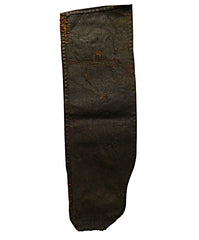A Leathery and Re-Fashioned Sakabukuro: Sake Making Filter
early twentieth century
29 3/4" x 9 1/2", 75.7 cm x 24 cm
Sakabukuro, or sake straining bags, are beautiful boro textiles. Made of cotton saturated with green persimmon tannin, or kaki shibu, which gives the distinctive brown color and "leathery" finish, this utilitarian textile was used in sake making.
Crude sake, or sake lees, was placed in this bag and pressure was applied to squeeze out and filter the liquid. Repeated use required repeated mendings and we see the wonderfully odd stitches applied for this purpose.
The bag is "leathery" for the distinctive surface quality which has developed a coating and patina due to the many times it was dipped into kaki shibu, a repeated action that coats the woven fibers and strengthens the fabric of the bag while at the same time changing the character of the cloth by making the surface shiny and slightly water resistant.
This is a nice example of a sakabukuro and it shows rough mending in the form of crude stitching--very attractive. As well, the bag has been re-shaped to be narrow at the bottom and we can only speculate as to why.
This is a handsome sakabukuro with simple and utilitarian mending.


